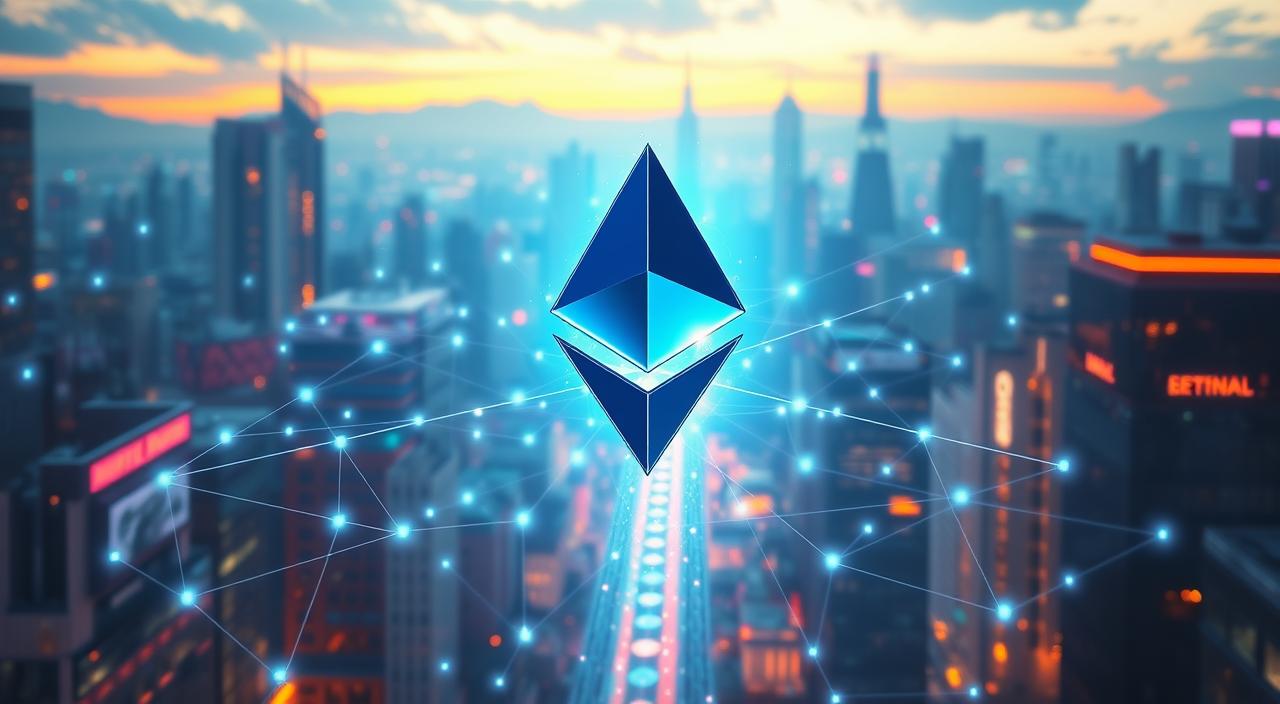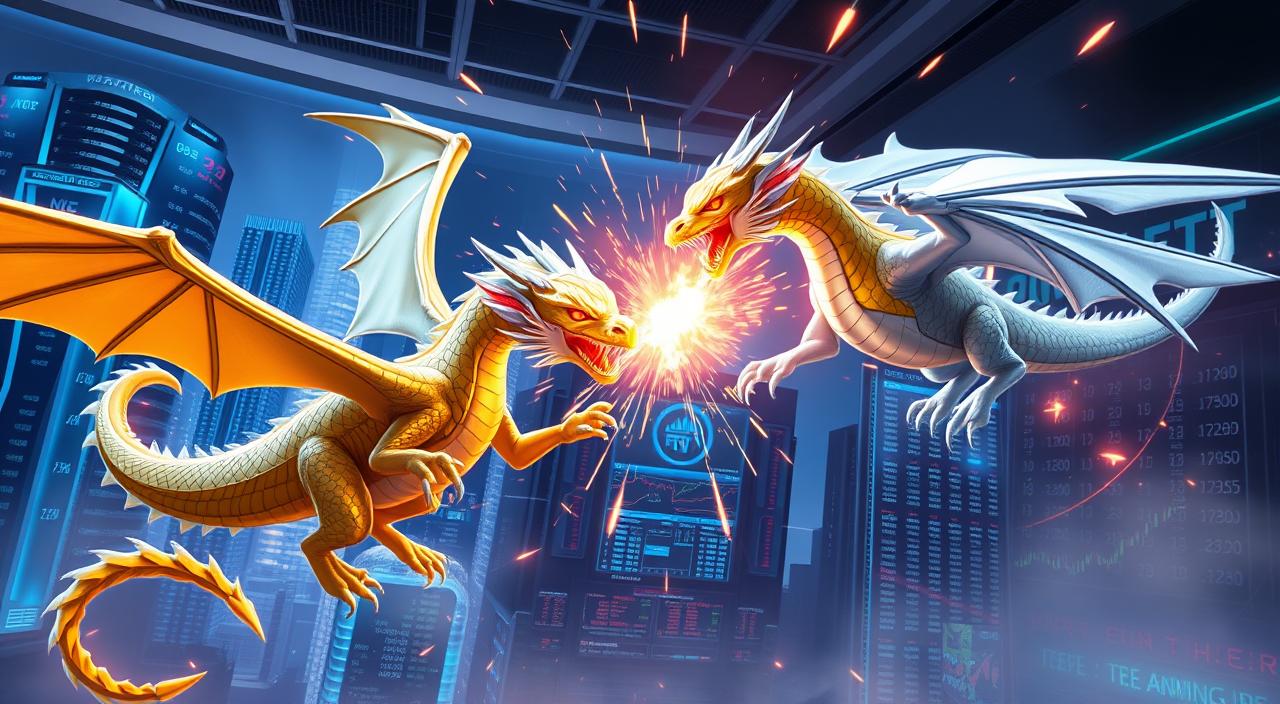Ethereum Explored: A Simple Overview of Blockchain Tech
Have you ever wondered why Ethereum is hailed as an innovation on par with the internet itself? For many, the term ‘blockchain’ evokes images of cryptocurrency and complex technology, but Ethereum’s blockchain ushers in a new paradigm in digital autonomy. Shedding light on Ethereum basics, this ethereum introduction will guide you through an understanding of ethereum, a platform that transcends ordinary currency. With the Ethereum blockchain’s rapid block time of 10 to 20 seconds, developers can create and execute code more dynamically than ever before, surpassing Bitcoin’s slower block periods1. Unlike its predecessor, Ethereum’s proof of work requires memory-intensive graphic cards, standing out from the ASIC-driven mining of Bitcoin1. Initiated by Vitalik Buterin and governed by the Ethereum Foundation, Ethereum is structured with business-like precision aiming for efficiency and broad accessibility in its operations1.
Key Takeaways:
- Ethereum speeds past Bitcoin with shorter block times to ensure quicker executions1.
- Graphic cards, not ASIC chips, are the choice hardware for Ethereum’s mining, impacting the network’s energy consumption1.
- Develop a more profound understanding of ethereum as not just a cryptocurrency platform, but a decentralized ecosystem for applications2.
- Learn about the ‘gas’ and ‘ether’ that fuel the Ethereum network, integral for the execution of smart contracts and decentralized apps1.
- Discover the role and ambitions of Ethereum in shaping business, finance, and the future digital world23.
- Ethereum’s transition to proof-of-stake marks a significant shift in reducing the network’s energy footprint3.
- Explorer gaming and other industry applications on the Ethereum blockchain, such as Decentraland and Axie Infinity3.
What is Ethereum and How Does It Revolutionize Technology?
As you delve into the ethereum guide, it’s crucial to understand that Ethereum is more than just digital money. Ethereum’s platform enables developers to build and deploy decentralized applications, making it a revolutionary force in technology4. Let’s explore how it’s apart from other blockchain technologies.
Decentralized Platform for Autonomous Applications
Ethereum is perhaps best known for its capability to operate autonomous applications or dApps without interference from third parties. What sets it apart is its decentralized nature, which eliminates single points of failure and ensures continuity and security across various applications. This attribute is particularly pivotal for users prioritizing transparency and direct control over their transactions and digital interactions4.
The Innovation of Smart Contracts on the Blockchain
Smart contracts are self-executing contracts with the agreement directly written into lines of code. The innovation of smart contracts on Ethereum4 allows automatic execution upon fulfilling set conditions, which substantially cuts down the need for intermediary oversight and thus reduces associated fees. This mechanism not only enhances the efficiency of transactions but also enforces the terms of the contract with absolute immutability once executed.
Understanding Ether: The Native Cryptocurrency
Ether (ETH), the native cryptocurrency of the Ethereum network, plays a critical role in the functioning of numerous processes. It is used to compensate participants performing computations and transactions. This form of “fuel” helps to maintain operations within the blockchain, ensuring that developers and users sustain the platform’s ecosystem4.
Furthermore, Ethereum’s move towards a Proof of Stake (PoS) consensus through ‘The Merge’ has marked a significant strategy shift aimed at energy efficiency and a potentially deflationary ecosystem, where the total supply of Ether was reduced, fundamentally altering how transactions are validated without compromising security or scalability5.
| Feature | Impact |
|---|---|
| Smart Contracts | Automate and secure transactions |
| Decentralized Applications | Operate without central control |
| Ether as Fuel | Powers operations, motivates miners |
| Proof of Stake | Energy-efficient, safer, and more scalable |
In conclusion, exploring what is ethereum and how it works provides an exciting vista into the future of decentralized technology. As ethereum for beginners becomes increasingly accessible, more users can engage with this innovative platform, driving forward the new era of internet interaction.
Ethereum Explored: A Simple Overview
If you’re delving into the world of cryptocurrencies, the term Ethereum certainly rings a bell. Often positioned as the queen to Bitcoin’s king in the realm of digital currencies, Ethereum offers a complex yet fascinating architecture aimed at revolutionizing how we interact with the digital world. Let’s unpack Ethereum for beginners to provide an ethereum overview that is clear and comprehensive.
Ethereum’s Architecture: Blockchain, Smart Contracts, and EVM
Ethereum is built on an intricate framework consisting of its blockchain technology, smart contracts, and the Ethereum Virtual Machine (EVM). The blockchain serves as a decentralized ledger that records all transactions across a network. The creation of Ethereum’s ETH token by Vitalik Buterin in 2015 marked a significant evolution in how such platforms could be leveraged for more than just transactions6.
Smart contracts, self-executing contracts with the terms directly written into code, are a core component of Ethereum, distinguishing it from other cryptocurrencies. These contracts automatically execute when certain conditions are met, eliminating the need for intermediaries and enhancing transparency and trust7.
The EVM, then, is essentially the engine under Ethereum’s hood, facilitating the operation and execution of these contracts across the network. It ensures that smart contracts and decentralized applications (DApps) run smoothly, maintaining a stable ecosystem for developers and users alike6.
The Role of Gas and Ether in Facilitating Transactions
In Ethereum, every operation, whether executing smart contracts or processing transactions, requires computational resources which are quantified as ‘gas.’ These gas units are paid for in Ether (ETH), Ethereum’s native cryptocurrency, linking operational requirements directly with the platform’s own token economy7.
Ether’s role extends beyond just fueling operations; it’s a key enabler of network security and participant engagement. Usage of ETH helps prevent spam, pays for transaction fees, and incentivizes validators participating in the network’s consensus mechanisms—importantly, in both the original proof-of-work and the more recent push towards proof-of-stake with Ethereum 2.0 aimed at improving scalability and energy efficiency7.
To give you a clearer understanding of Ethereum’s transactional ecosystem, below is a detailed table showcasing the Ethereum transaction elements:
| Component | Function | Connected to ETH |
|---|---|---|
| Gas | Measures computational work | Yes |
| Ether (ETH) | Currency for paying gas | Yes |
| Smart Contracts | Autonomous, self-executing contracts | Operated via transactions paid in ETH |
| EVM | Executes operations on the network | Hosts and runs DApps using ETH |
As Ethereum continues to evolve, especially with the advent of The Merge transitioning from PoW to PoS, understanding these aspects becomes paramount for anyone engaged in the field of decentralized finance or interested in the broader implications of blockchain technologies6. So, whether you’re a developer, investor, or merely a curious observer, understanding Ethereum’s architecture and transactional components is essential for grasping how it’s reshaping digital interactions7.
Hopefully, this ethereum explained guide helps illuminate the robust framework that Ethereum operates on, making your journey into cryptocurrencies both informed and engaging.
The Mechanics of Ethereum Transactions and Smart Contracts
In this section, we delve into the ethereum basics that underpin its transaction mechanisms and the revolutionary potential of smart contracts. As we explore ethereum explored: a simple overview and understanding ethereum, you’ll gain insights into why these components are crucial for the technology’s functionality and widespread adoption.
The Synergy Between Gas, Ether, and Network Reliability
Ethereum operates through a unique interplay between Ether (ETH), gas, and its decentralized network. Transactions on the Ethereum blockchain—be they simple transfers or complex interactions with smart contracts—require ‘gas,’ a fee that powers the Ethereum Virtual Machine (EVM). Notably, every transaction must provide enough gas, calculated in units of gwei, to cover its computational needs, ensuring network security and efficiency by preventing spam and compensating miners for their computational efforts89.
At the heart of Ethereum’s robust network are two distinct account types: externally-owned accounts (EOAs) and contract accounts. Each operates within the framework, with EOAs initiating transactions propelled by human users and contract accounts governed by the predetermined rules of smart contracts9. This structure supports the Ethereum network’s Turing completeness, enabling it to execute any feasible computation given sufficient time and resources, thus broadening its utility far beyond simple transactional use89.
Smart Contracts: The Future of Digital Agreements
Smart contracts represent a paradigm shift in executing and enforcing agreements. Written primarily in programming languages like Solidity or Vyper, these self-operating contracts execute transactions automatically when their conditions are met, without the need for intermediaries8. Once a smart contract is deployed on the blockchain, it becomes part of a globally distributable database that everyone on the network can validate, ensuring transparency and trust8.
Moreover, these contracts compile into bytecode for the EVM to execute, ensuring that their logic operates in a sandboxed environment for added security8. Developers typically employ tools like the Ethereum Remix IDE for testing and deploying these contracts, which further highlights the platform’s user-friendly approach to decentralized application development8.
| Smart Contract Tool | Usage |
|---|---|
| Ethereum Remix IDE | Testing and deploying smart contracts |
| Solidity and Vyper | Programming languages for writing smart contracts |
| Hardhat & Foundry | Development environments used for compiling, deploying, and testing Ethereum contracts |
| EVM | Executes contracts’ bytecode in a secure environment |

Understanding the fundamentals of Ethereum, including the mechanics behind transactions and smart contracts, not only illuminates how this blockchain works but also its vast potential. By learning about how Ethereum leverages gas, Ether, and smart contracts to maintain network reliability and security, you are better equipped to foresee how it might evolve and be applied across various sectors.
Ethereum’s Virtual Machine: The Backbone of Decentralized Computing
Exploring the realm of decentralized computing, the Ethereum Virtual Machine (EVM) stands out as a pivotal element, especially for those keen on understanding what is Ethereum. Positioned at the core of this blockchain-based platform, the EVM facilitates not just the processing of transactions but also the robust execution and management of smart contracts and decentralized applications (DApps). This remarkable capability stems from the EVM’s design to operate as a completely isolated system, ensuring error-free and secure execution environment that supports a vast array of applications, from complex financial contracts to social networks.
How the EVM Manages Smart Contracts and Decentralized Apps
The EVM’s role is quintessential in the Ethereum ecosystem, handling all transactions and smart contract executions efficiently. For example, with its capability to process transactions including ETH token transfers, the EVM underpins Ethereum’s status as a cornerstone for DApp development and deployment10. From leveraging ERC-20 tokens, which are primarily used for creating stablecoins like USDT, to enabling decentralized finance (DeFi) platforms where users can lend or borrow cryptocurrencies without intermediaries, the EVM plays a central role10. Moreover, platforms such as Uniswap and SushiSwap utilize these smart contracts to facilitate trading without the need for a third party, which is a testament to the EVM’s capacity to support highly functional and autonomous systems10.

The EVM also ensures that non-fungible tokens (NFTs), like those from popular collections such as Bored Ape Yacht Club and Cryptopunks, are authenticated—maintaining a transparent and secure means of trading digital assets on platforms like OpenSea10. It’s this flexibility and security that provide a solid foundation for DApps and promote the continuous evolution and adoption of blockchain technology within modern digital economies.
The Importance of Consensus in Ethereum: From PoW to PoS
A cornerstone feature of Ethereum’s operational protocol is the transition from Proof of Work (PoW) to Proof of Stake (PoS), a move designed to enhance network scalability and security10. The Ethereum network relies on Validators, who stake a substantial amount as a commitment to managing transactions and creating new blocks responsibly. This mechanism not only fortifies the network’s resilience against fraudulent activities but also supports a faster and more energy-efficient transaction validation process11.
The consensus protocol is imperative as it facilitates agreement on the state of the ledger, ensuring that each transaction is accurately recorded and immutably linked in the blockchain. Validators are essential in this process, playing a dual role in proposing new blocks and validating transactions, thereby maintaining the ledger’s integrity and facilitating the continuous growth and stability of the Ethereum network1011.
As the world of decentralized finance continues to expand, the EVM’s ability to adapt and integrate new technological advancements like the Ethereum Improvement Proposal EIP-4844 remains critical. This evolution marks a significant leap forward in how the EVM will manage future demands, further solidifying its position at the heart of Ethereum’s decentralized matrix10.
In summary, the Ethereum explained in this section showcases how intrinsic the Ethereum Virtual Machine is, not only to Ethereum guide enthusiasts but to the broader scope of blockchain applications. The versatile and dependable nature of the EVM ensures Ethereum remains a dynamic and influential force in the realm of blockchain technology.
The Evolving Landscape of Ethereum: From Cryptocurrency to Dapps
As you delve into ethereum basics, it’s crucial to recognize Ethereum not just as a cryptocurrency platform but as a continuously evolving ecosystem supporting a myriad of decentralized applications (Dapps). The platform’s leap from a mere digital currency to a robust development framework demonstrates its exponential potential and innovation12.
The Continuous Development and Potential of Ethereum
The Ethereum network, known for its progressive Ethereum Virtual Machine (EVM), is the backbone facilitating complex smart contracts, which are self-executing contracts with the terms directly written into code1312. These smart contracts fuel everything from financial services to gaming and have gained traction for being transparent and reducing transaction times significantly13. With the introduction of features like gas and Ether, Ethereum ensures that developers can run applications smoothly, mitigating spam and managing network security13.
“Ethereum’s evolution is marked by relentless innovation, extending beyond financial applications to create a diverse array of business solutions that challenge traditional models and pave the way for a decentralized future.”
Further illustrating its capacity for impact, Ethereum hosts several effective Dapps like Uniswap and Aave, which showcase the practical use of decentralization in creating open and efficient digital markets14. These platforms not only exemplify Ethereum’s application in financial ecosystems but also highlight its broader applicability in numerous sectors14.
Ethereum’s Place in the Corporate World and Its Impact on Business
Ethereum for beginners might seem focused on technical details, but its implications in the business world are vast and profound. By facilitating decentralized applications, Ethereum offers a blueprint for a new kind of business logic that intersects with leading technologies like blockchain and smart contracts12. Giants in technology and finance like Microsoft and JPMorgan Chase have explored Ethereum-based projects, signaling a shift towards more transparent and reliable business processes facilitated by blockchain technology12.
Moreover, with Ethereum’s transition from Proof of Work (PoW) to Proof of Stake (PoS), it is setting new standards for environmental responsibility in the blockchain space, enhancing its appeal to environmentally conscious investors and stakeholders12.
As you explore what is Ethereum, consider its profound ability to transform not just markets but also corporate governance and operational methodologies. Its embrace by the Enterprise Ethereum Alliance underscores its potential to revolutionize industries by offering scalable, secure, and customizable solutions12.
Ethereum’s journey from a programmable blockchain to a foundational element in the development of decentralized applications underscores its role as a critical catalyst in the ongoing evolution of the digital landscape12. As it continues to develop and adapt, the possibilities for Ethereum to influence various sectors of the economy are limitless12.
Minting and Burning: The Economic Model of Ether
As you delve into the ethereum guide, it’s essential to understand the dynamic economic model of Ether, which prominently features minting and burning processes. These processes not only define the financial underpinnings but also significantly influence the ethereum overview.
The Significance of Ether’s Denominations and Usage
Ether, the native token of the Ethereum network, plays a crucial role in powering a vast array of decentralized applications and is integral to the operational mechanics of the network. Ether is divided into smaller denominations, such as wei and gwei, ensuring precision in transaction fees and gas calculations. This divisibility facilitates flexible and efficient transaction processing on the Ethereum blockchain15.
In this ethereum explored: a simple overview, it’s worth noting that the broader usability of Ether stretches beyond mere transaction fees; it’s widely used as a payment method for goods and services within the Ethereum ecosystem and as collateral in decentralized finance (DeFi) lending markets15. Moreover, the continuous minting of Ether as a reward for validators—particularly at epoch checkpoints—plays a pivotal role in the network’s security and viability15.
Understanding the Process of Ether Transactions
Every transaction within the Ethereum network requires the burning of Ether, specifically a portion of the base transaction fee. This process is crucial for reducing the total supply of Ether, thereby instituting a potentially deflationary economic environment. Post-merge, the introduction of Proof of Stake (PoS) significantly altered the burn rates and issuance, fostering a net decrease in supply and thus, contributing to the notion of ‘ultrasound money’16.
The burning mechanism is designed to prevent fee manipulation by block producers, ensuring a transparent and fair fee structure across the network. This, combined with a reduction of block rewards in the new PoS model, introduces a deflationary pressure on Ether’s supply, pivotal in maintaining network integrity and value16.
To provide a clearer perspective on the economic dynamics of Ether, below is a comparative table summarizing key aspects post the transition to Proof of Stake:
| Aspect | Pre-Merge | Post-Merge |
|---|---|---|
| Issuance Rate | 13,500 ETH/day | 1,600 ETH/day16 |
| Burn Rate | Variable | Approximately 5,000 ETH/day16 |
| Net Supply Change | Increase | Decrease of about 3,500 ETH/day16 |
| Supply Type | Inflationary | Deflationary17 |
The table above illustrates the transformative impact of the PoS mechanism on Ethereum’s economic layout, revealing how strategic changes in Ether’s minting and burning rates are essential to its ongoing development and sustainability in the bustling world of cryptocurrencies.
The Future of Finance and Digital Ownership: DeFi and NFTs (Non-Fungible Tokens)
As you deepen your understanding of Ethereum, it’s apparent that its capabilities extend far beyond what traditional financial systems offer. With the advent of decentralized finance (DeFi), Ethereum has established a platform where monetary transactions, lending, and borrowing can occur without the intervention of centralized institutions. These new forms of commerce, powered by smart contracts, offer a transparency and fluidity unseen in traditional banking, with money predominantly tied up in cryptocurrency only accounting for a mere 0.56% in the U.S18.. Furthermore, with innovations such as NFTs, Ethereum supports the creation of indisputable digital ownership for assets that are otherwise easily duplicated and resold. The assurance that an asset like digital art or collectibles has only one official owner at any given time fortifies the value of digital creations for artists and collectors alike19.
Ethereum explained isn’t just about its native cryptocurrency, Ether, or how Ethereum introduction has changed the status quo; it’s about grasping the transformative ecosystem that DeFi platforms have nurtured. These platforms facilitate a host of financial activities—lending, borrowing, and even interest-earning—all while ensuring robust security measures. Records of each procedure are immutably recorded on the blockchain without compromising the privacy of the parties involved. In connection with the arts and entertainment industry, the implementation of protocols such as SPL-404 on alternative blockchains aims to address the issues of high gas fees and transaction speeds, thus enhancing the functionality of NFTs20. Ethereum’s technology has been fundamental in elevating DeFi and solidifying the unique identifiers of NFTs that defy duplication19.
Embracing the future of finance means acknowledging the synergy of DeFi and NFTs, where unique digital assets can now serve as collateral in a loan on DeFi applications. Peer-to-peer transactions underscore the essence of a decentralized system, eradicating the need for middlemen and revolutionizing the way users engage with financial services1820. As the Ethereum Virtual Machine (EVM) streamlines smart contracts, Ethereum Request for Comments (ERC) standards ensure the smooth interoperability of these digital tokens on its expansive platform, unlocking endless possibilities for a global, open-source financial sector19. Thus, as you continue your journey in understanding Ethereum, you witness a paradigm shift in how we transact, earn, and claim ownership in an increasingly digital economy.








Post Comment